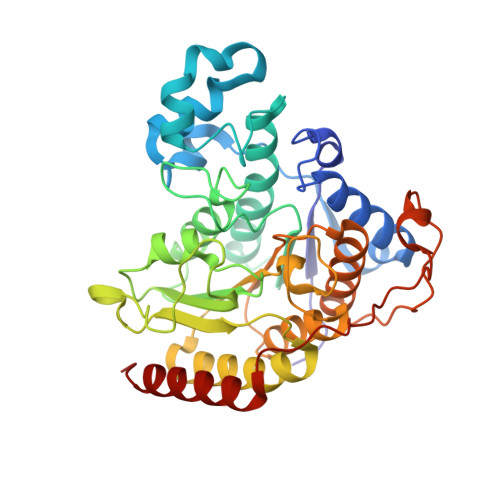Kinetic and structural insights into the binding of histone deacetylase 1 and 2 (HDAC1, 2) inhibitors.
Wagner, F.F., Weiwer, M., Steinbacher, S., Schomburg, A., Reinemer, P., Gale, J.P., Campbell, A.J., Fisher, S.L., Zhao, W.N., Reis, S.A., Hennig, K.M., Thomas, M., Muller, P., Jefson, M.R., Fass, D.M., Haggarty, S.J., Zhang, Y.L., Holson, E.B.(2016) Bioorg Med Chem 24: 4008-4015
- PubMed: 27377864
- DOI: https://doi.org/10.1016/j.bmc.2016.06.040
- Primary Citation of Related Structures:
5IWG, 5IX0 - PubMed Abstract:
The structure-activity and structure-kinetic relationships of a series of novel and selective ortho-aminoanilide inhibitors of histone deacetylases (HDACs) 1 and 2 are described. Different kinetic and thermodynamic selectivity profiles were obtained by varying the moiety occupying an 11Å channel leading to the Zn(2+) catalytic pocket of HDACs 1 and 2, two paralogs with a high degree of structural similarity. The design of these novel inhibitors was informed by two ligand-bound crystal structures of truncated hHDAC2. BRD4884 and BRD7232 possess kinetic selectivity for HDAC1 versus HDAC2. We demonstrate that the binding kinetics of HDAC inhibitors can be tuned for individual isoforms in order to modulate target residence time while retaining functional activity and increased histone H4K12 and H3K9 acetylation in primary mouse neuronal cell culture assays. These chromatin modifiers, with tuned binding kinetic profiles, can be used to define the relation between target engagement requirements and the pharmacodynamic response of HDACs in different disease applications.
Organizational Affiliation:
Stanley Center for Psychiatric Research, Broad Institute of MIT and Harvard, 75 Ames Street, Cambridge, MA, USA. Electronic address: fwagner@broadinstitute.org.






















